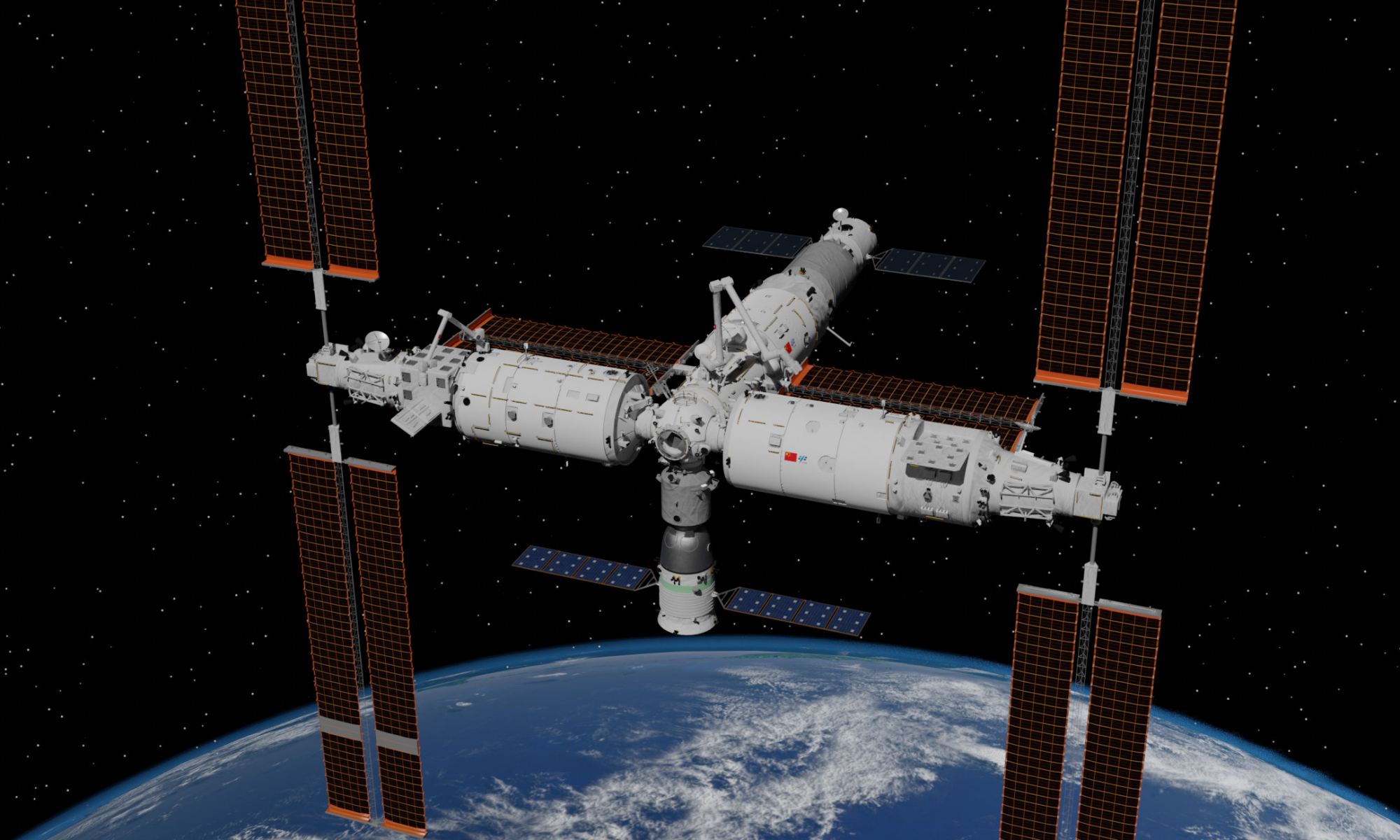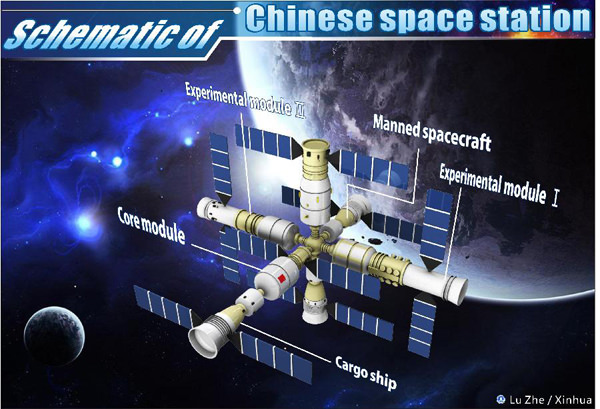On the afternoon of Monday, October 31st, 2022 (Halloween!), China launched the Mengtian laboratory cabin module into space, where it will join the Tiangong modular space station. This module, whose name translates to “Dreaming of the Heavens,” is the second laboratory and final addition to Tiangong (“Palace in the Sky”). This successful launch places China one step closer to completing its first long-term space station, roughly one-fifth the mass of the International Space Station (ISS) and comparable in size to Russia’s decommissioned Mir space station.
Continue reading “China Launches Mengtian, the Last Major Module to its Space Station”The First Chinese Crew is Busy on their New Space Station
On Thursday, June 17th, China took another major step in its ongoing drive to become a superpower in space. Just two months after the core module of the Tiangong space station (literally, “Heavenly Palace”) was sent to orbit, the three astronauts that will be the station’s first crew launched to space. The mission, Shenzhou 12, lifted off atop a Long March-2F rocket at 09:22 p.m. on Wednesday evening local time (09:22 a.m. EDT; 06:22 a.m. PDT) from the Jiuquan launch center in the Gobi desert.
Continue reading “The First Chinese Crew is Busy on their New Space Station”Spaceflight Stories Expected for 2020
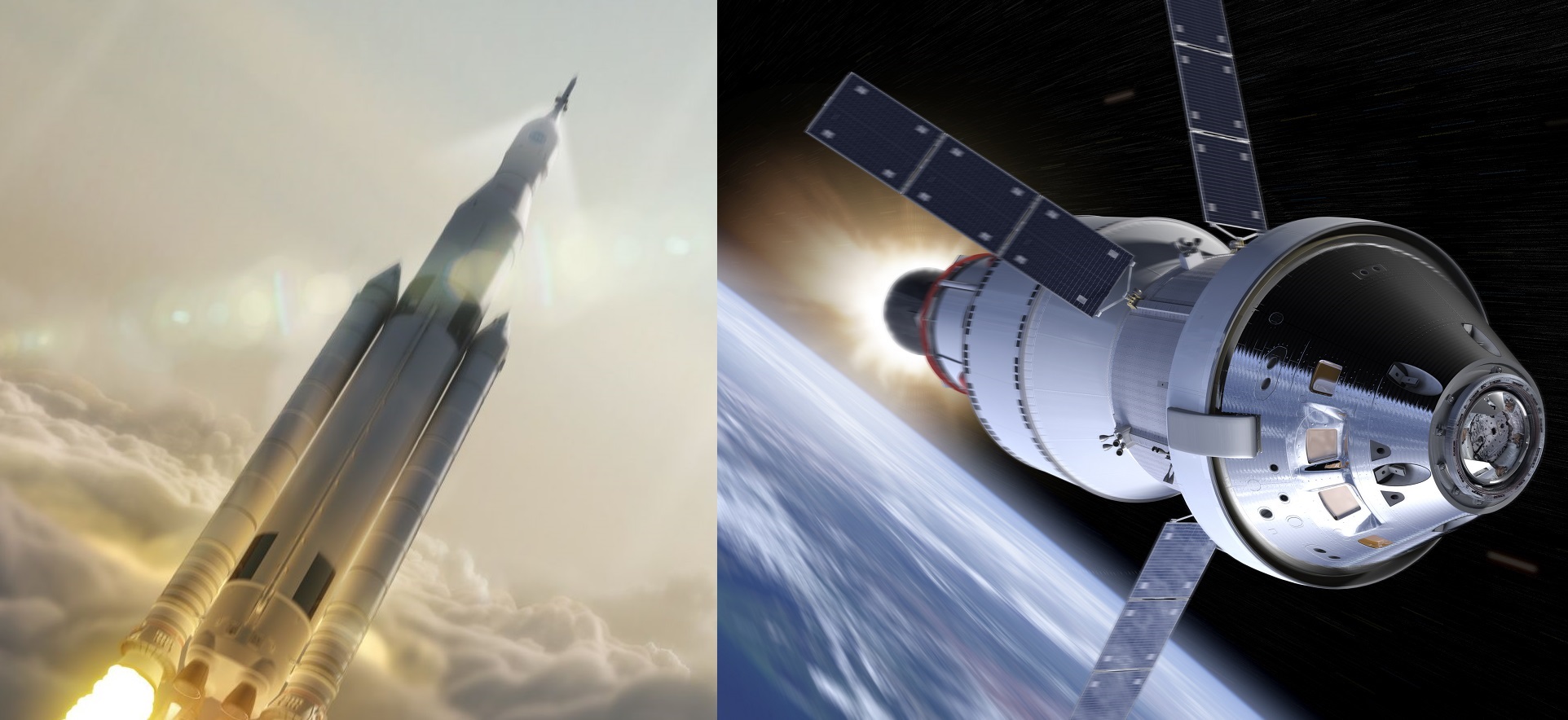
The year two thousand and twenty is almost upon us. And as always, space agencies and aerospace companies all around the world are preparing to spend the coming year accomplishing a long list of missions and developments. Between NASA, the ESA, China, SpaceX, and others, there are enough plans to impress even the most curmudgeonly of space enthusiasts.
Continue reading “Spaceflight Stories Expected for 2020”Here’s How to Follow the De-Orbit of Tiangong-1, now Estimated to Happen Between March 30 and April 2
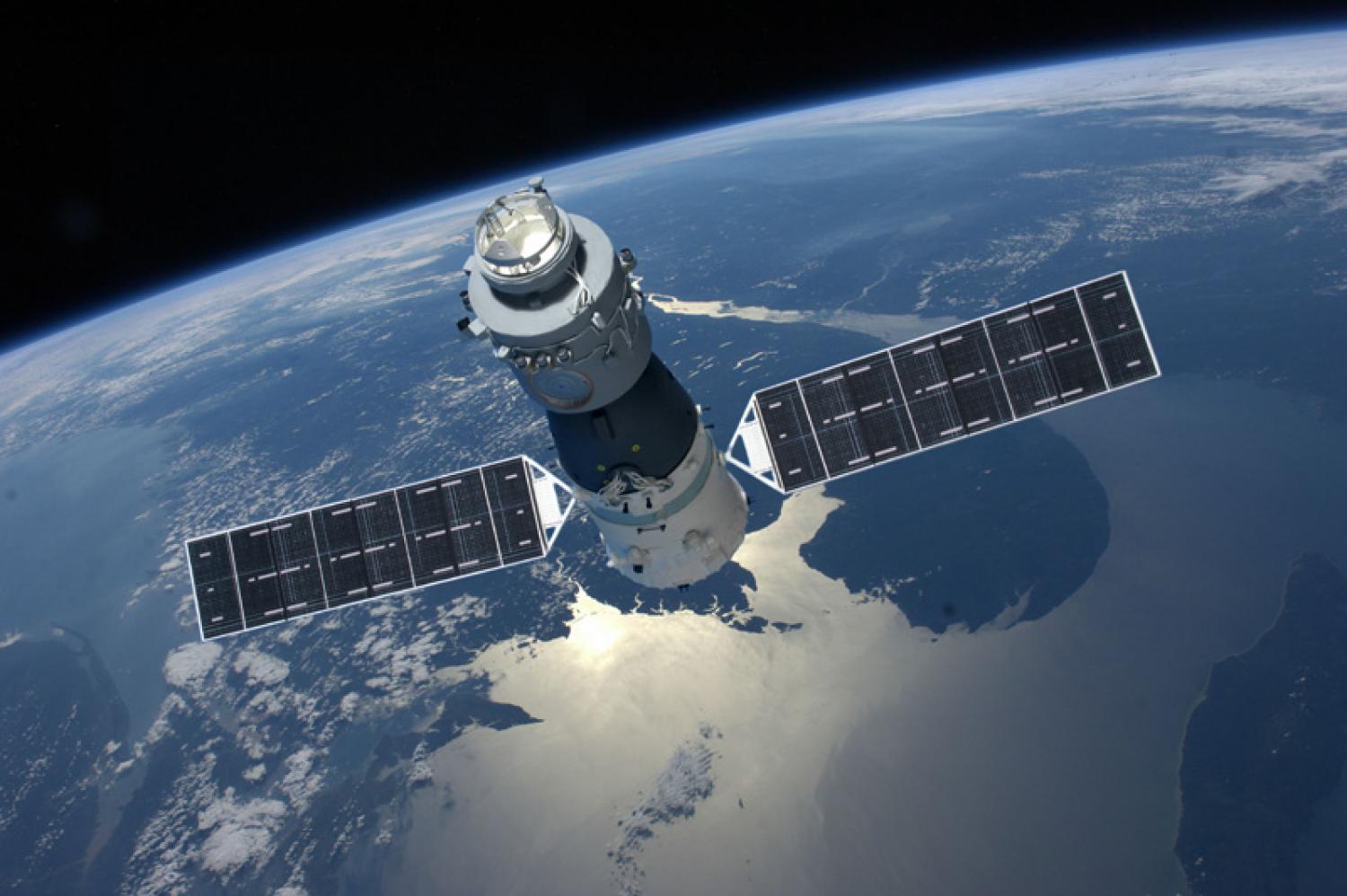
China’s Tiangong-1 space station has been the focus of a lot of international attention lately. In 2016, after four and half years in orbit, this prototype space station officially ended its mission. By September of 2017, the Agency acknowledged that the station’s orbit was decaying and that it would fall to Earth later in the year. Since then, estimates on when it will enter out atmosphere have been extended a few times.
According to satellite trackers, it was predicted that the station would fall to Earth in mid-March. But in a recent statement (which is no joke) the Chinese National Space Agency (CNSA) has indicated that Tiangong-1 will fall to Earth around April 1st – aka. April Fool’s Day. While the agency and others insists that it is very unlikely, there is a small chance that the re-entry could lead to some debris falling to Earth.
For the sake of ensuring public safety, the European Space Agency’s (ESA) Space Debris Office (SDO) has been providing regular updates on the station’s decay. According to the SDO, the reentry window is highly variable and spans from the morning of March 31st to the afternoon of April 1st (in UTC time). This works out to the evening of March 30th or March 31st for people living on the West Coast.
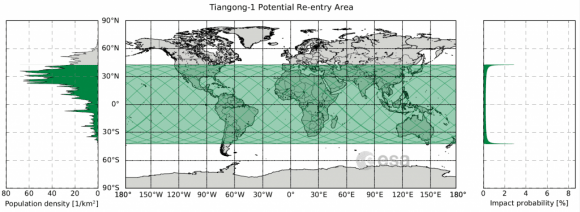
As the ESA stated on their rocket science blog:
“Reentry will take place anywhere between 43ºN and 43ºS. Areas above or below these latitudes can be excluded. At no time will a precise time/location prediction from ESA be possible. This forecast was updated approximately weekly through to mid-March, and is now being updated every 1~2 days.”
In other words, if any debris does fall to the surface, it could happen anywhere from the Northern US, Southern Europe, Central Asia or China to the tip of Argentina/Chile, South Africa, or Australia. Basically, it could land just about anywhere on the planet. On the other hand, back in January, the US-based Aerospace Corporation released a comprehensive analysis on Tiangong-1s orbital decay.
Their analysis included a map (shown below) which illustrated the zones of highest risk. Whereas the blue areas (that make up one-third of the Earth’s surface) indicate zones of zero probability, the green area indicates a zone of lower probability. The yellow areas, meanwhile, indicates zones that have a higher probability, which extend a few degrees south of 42.7° N and north of 42.7° S latitude, respectively.
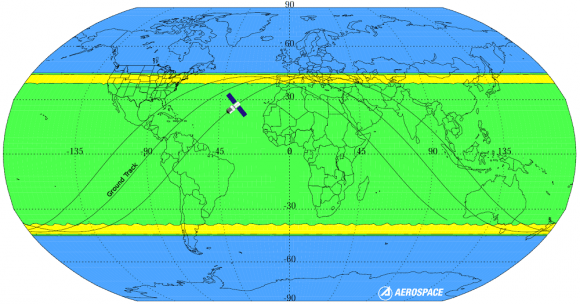
The Aerospace Corporation has also created a dashboard for tracking Tiangong-1 (which is refreshed every few minutes) and has come to similar conclusions about the station’s orbital decay. Their latest prediction is that the station will descend into our atmosphere on April 1st, at 04:35 UTC (March 30th 08:35 PST), with a margin of error of about 24 hours – in other words, between March 30th to April 2nd.
And they are hardly alone when it comes to monitoring Tiangong-1’s orbit and predicting its descent. The China Human Spaceflight Agency (CMSA) recently began providing daily updates on the orbital status of Tiangong-1. As they reported on March 28th: “Tiangong-1 stayed at an average altitude of about 202.3 km. The estimated reentry window is between 31 March and 2 April, Beijing time.”
The US Space Surveillance Network, which is responsible for tracking artificial objects in Earth’s orbit, has also been monitoring Tiangong-1 and providing daily updates. Based on their latest tracking data, they estimate that the station will enter our atmosphere no later than midnight on April 3rd.
Naturally, one cannot help but notice that these predictions vary and are subject to a margin of error. In addition, trackers cannot say with any accuracy where debris – if any – will land on the planet. As Max Fagin – an aerospace engineer and space camp alumni – explained in a recent Youtube video (posted below), all of this arises from two factors: the station’s flight path and the Earth’s atmosphere.
Basically, the station is still moving at a velocity of 7.8 km/sec (4.8 mi/s) horizontally while it is descending by about 3 cm/sec. In addition, the Earth’s atmosphere shrinks and expands throughout the day in response to the Sun’s heating, which results in changes in air resistance. This makes the process of knowing where the station’s will make its descent difficult to predict, not to mention where debris could fall.
However, as Fagin goes on to explain, once the station reaches an altitude of 150 km (93 mi) – i.e. within the Thermosphere – it will begin falling much faster. At that point, it be much easier to determine where debris (if any) will fall. However, as the ESA, CNSA, and other trackers have emphasized repeatedly, the odds of any debris making it to the surface is highly unlikely.
If any debris does survive re-entry, it is also statistically likely to fall into the ocean or in a remote area – far away from any population centers. But in all likelihood, the station will break up completely in our atmosphere and produce a beautiful streaking effect across the sky. So if you’re checking the updates regularly and are in a part of the world where it can be seen, be sure to get outside and see it!
Further Reading: GB Times
China Says it Still has Control Over Tiangong-1 and Can Decide Where It’ll Crash

The Tiangong-1 space station has been the subject of a lot of interest lately. Though its mission was meant to end in 2013, the China National Space Agency extended its service until 2016. In September of 2017, after much speculation from the international community, the Agency acknowledged that the station’s orbit was degrading and that it would fall to Earth later in the year.
Based on updates from satellite trackers, it has been indicated that Tianglong-1 will likely reenter our atmosphere in March of 2018, with the possibility of debris making it to the surface. However, according to a statement made by a top engineer at the China Aerospace Science and Technology Corporation (CASTC), reports that the Chinese National Space Agency (CNSA) has lost control of the space station have been wildly exaggerated.
The statement came from Zhu Congpeng, a top engineer at the China Aerospace Science and Technology Corporation (CASTC). As he was quoted as saying to the Science and Technology Daily newspaper – a state-backed Chinese science journal – the CNSA is still in control of the space station, it’s reentry will be controlled, and it will not pose a threat to the environment or any population centers.
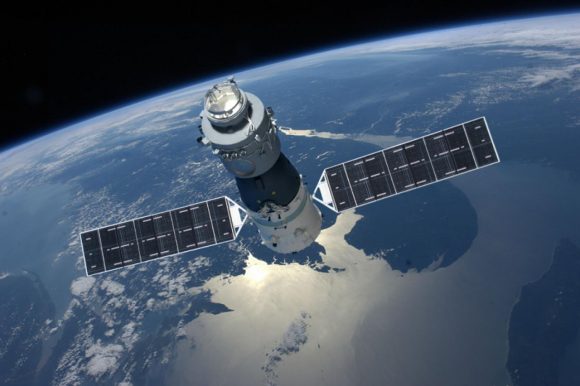
Previously, the CNSA claimed that the majority of the station would burn up in orbit, with only small pieces falling to the Earth. But according to Zhu Congpeng’s statement, when the station burns up in the atmosphere, the remaining debris will not jeopardize people, infrastructure or the environment anywhere on the surface. As Zhu Congpeng stated:
“We have been continuously monitoring Tiangong-1 and expect to allow it to fall within the first half of this year. It will burn up on entering the atmosphere and the remaining wreckage will fall into a designated area of the sea, without endangering the surface.”
As with previous missions – like the Mir space station, the Russian Progress spacecraft, and NASA’s Compton Gamma-Ray Observatory – the designated crash site is a deep-sea area in the South Pacific known as the “spacecraft cemetery”. As a further indication that the CNSA is still in control of Tiangong-1, Zhu claimed that the CNSA has been constantly monitoring the space station since the end of its mission.
“The latest bulletin shows that on December 17-24, 2017, Temple One runs on an orbit with an average height of about 286.5 kilometers (height of about 272.6 kilometers near perigee, height of about 300.4 kilometers at apogee and inclination of about 42.85 degrees), attitude stability,” he said. “There is no abnormal morphology.”

He also emphasized that the station’s reentry was delayed until September in order to ensure the the wreckage would fall into the South Pacific. In other words, the position of Tiangong-1 is something the Chinese have been monitoring closely, and they will continue to do so when it reenters the atmosphere this coming March. This latest statement comes on the heels of statements made by both China’s manned space engineering office and the Aerospace Corporation, which appeared to offer a different appraisal.
Back in mid-September, Wu Ping – the deputy director of China’s manned space engineering office – stated at a press conference that there was some chance that debris would land on Earth. While she was insistent that the odds of any debris surviving the passage through Earth’s atmosphere were minimal, it did suggest that the reentry would be uncontrolled.
This echoed the comprehensive report recently issued by the Aerospace Corporation, which stated that the Chinese space agency was unlikely to remain in control of Tiangong-1’s for the entirety of its reentry. Much like Wu, they also emphasized that the majority of the station would burn up on reentry and that it was unlikely that any debris would make it to the surface and cause damage.
As such, its not entirely clear if the reentry will be entirely controlled or not. But even if it should prove to be the latter, there is little reason to worry. As the Aerospace Corporation stated in their report:
“[T]he probability that a specific person (i.e., you) will be struck by Tiangong-1 debris is about one million times smaller than the odds of winning the Powerball jackpot. In the history of spaceflight, no known person has ever been harmed by reentering space debris. Only one person has ever been recorded as being hit by a piece of space debris and, fortunately, she was not injured.”
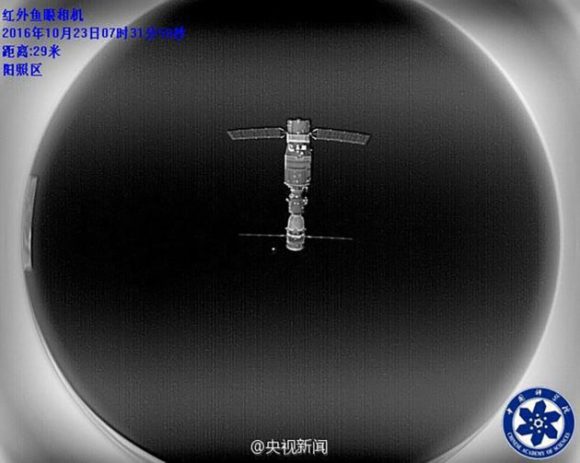
On top of that, the European Space Agency’s Inter Agency Space Debris Coordination Committee (IADC) will also be monitoring the reentry closely. They’ll also be using the occasion to conduct a test campaign designed to improve the accuracy of reentry predictions. And so far, all their predictions indicate that come March, people on Earth will be safe from falling debris.
So if you happen to live close to the equator, this coming March is sure to be an exciting time for sky-watchers! And if there’s any chance of debris landing where you live, you can sure you’ll hear about it well in advance.
Further Reading: Independent, STDaily
In mid-March, the Chinese Tiangong-1 Space Station is Going to Come Crashing Back Down to Earth… Somewhere

In September of 2011, China officially joined the Great Powers in Space club, thanks to the deployment of their Tiangong-1 space station. Since then, this prototype station has served as a crewed orbital laboratory and an experimental testbed for future space stations. In the coming years, China hopes to build on the lessons learned with Tiangong-1 to create a larger, modular station in 2023 (similar to the International Space Station).
Though the station’s mission was originally meant to end in 2013, the China National Space Agency extended its service to 2016. By September of 2017, the Agency acknowledged that they had lost control of the station and indicated that it would fall to Earth later in the year. According to the latest updates from satellite trackers, Tianglong-1 is likely to be reentering our atmosphere in March of 2018.
Given the fact that the station measures 10 by 3.35 meters (32.8 by 11 ft), weighs a hefty 8,506 kg (18,753 lb) and was built from very durable construction materials, there are naturally concerns that some of it might survive reentry and reach the surface. But before anyone starts worrying about space debris falling on their heads, there are a few things that need to be addressed.
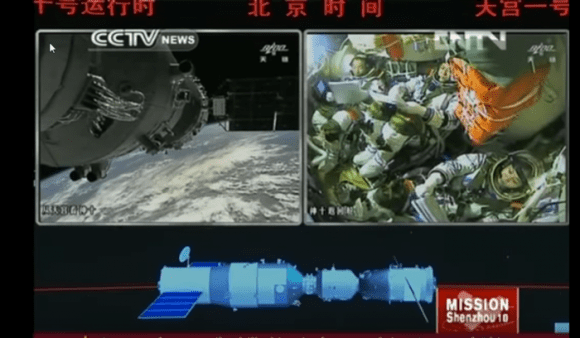
For starters, in the history of space flight, there has not been a single confirmed death caused by falling space debris. Tthanks to the development of modern tracking and early warning systems, we are also more prepared than at any time in our history for the threat of falling debris. Statistically speaking, you are more likely to be hit by falling airplane debris or eaten by a shark.
Second, the CNSA has emphasized that the reentry is very unlikely to pose a threat to commercial aviation or cause any impact damage on the surface. As Wu Ping – the deputy director of the manned space engineering office – indicated at a press conference back on September 14th, 2017: “Based on our calculation and analysis, most parts of the space lab will burn up during falling.”
In addition, The Aerospace Corporation, which is currently monitoring the reentry of Tiangong-1, recently released the results of their comprehensive analysis. Similar to what Wu stated, they indicated that most of the station will burn up on reentry, though they acknowledged that there is a chance that small bits of debris could survive and reach the surface. This debris would likely fall within a region that is centered along the orbital path of the station (i.e. around the equator).
To illustrate the zones of highest risk, they produced a map (shown below) which indicates where the debris would be most likely to land. Whereas the blue areas (that make up one-third of the Earth’s surface) indicate zones of zero probability, the green area indicates a zone of lower probability. The yellow areas, meanwhile, indicates zones that have a higher probability, which extend a few degrees south of 42.7° N and north of 42.7° S latitude, respectively.

To add a little perspective to this analysis, the company also indicated the following:
“When considering the worst-case location (yellow regions of the map) the probability that a specific person (i.e., you) will be struck by Tiangong-1 debris is about one million times smaller than the odds of winning the Powerball jackpot. In the history of spaceflight, no known person has ever been harmed by reentering space debris. Only one person has ever been recorded as being hit by a piece of space debris and, fortunately, she was not injured.”
Last, but not least, the European Space Agency’s Inter Agency Space Debris Coordination Committee (IADC) will be monitoring the reentry. In fact, the IADC – which is made up of space debris and other experts from NASA, the ESA, JAXA, ISRO, KARI, Roscosmos and the China National Space Administration – will be using this opportunity to conduct a test campaign.
During this campaign, participants will combine their predictions of the reentry’s time window, which are based on respective tracking datasets obtained from radar and other sources. Ultimately, the purpose of the campaign is to improve prediction accuracy for all member states and space agencies. And so far, their predictions also indicate that there is little cause for concern.
As Holger Krag, the Head of ESA’s Space Debris Office, indicated in a press statement back in November:
“Owing to the geometry of the station’s orbit, we can already exclude the possibility that any fragments will fall over any spot further north than 43ºN or further south than 43ºS. This means that reentry may take place over any spot on Earth between these latitudes, which includes several European countries, for example. The date, time and geographic footprint of the reentry can only be predicted with large uncertainties. Even shortly before reentry, only a very large time and geographical window can be estimated.”
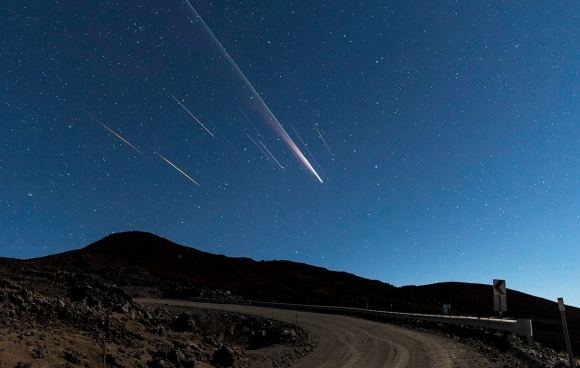
The ESA’s Space Debris Office – which is based at the European Space Operations Centre in Darmstadt, Germany – will follow this campaign in February with an international expert workshop. This workshop (which will run from February 28th to March 1st, 2018) will focus on reentry predictions and atmospheric break-up studies and allow experts in the field of space debris monitoring to share their latest findings and research.
In the current age of renewed space exploration and rapidly improving technology, every new development in space is an opportunity to test the latest instruments and methods. The reentry of Tiangong-1 is a perfect example, where the reentry of a space station is being used to test our ability to predict falling space debris. It also highlights the need for tracking and monitoring, given that humanity’s presence in orbit is only going to increase in the coming years.
In the meantime, it would not be inadvisable to keep your eyes on the skies this coming March. While there is little chance that debris will pose a hazard, it is sure to be spectacular sight for people who live closer to the equator!
Further Reading: Aerospace.org, ESA, Xinhuanet
China’s Shenzhou-8 Mission Poised For Launch
[/caption]
What’s new in space flight? With only days to go, China is ready to launch an unmanned spacecraft that will attempt to dock with an experimental space station module – Tiangong 1. The Shenzhou 8 mission is the latest step in what will be a decade-long effort to place a manned permanent space station in orbit.
The official Xinhua News Agency announced the craft is ready to embark on a series of maneuvers to connect with the Tiangong 1 module. The orbiting craft was launched in the latter half of September and continuing to perform as expected. The unmanned craft and its modified Long March-2F launch rocket were transferred via a 20-meter-wide railway early Wednesday. Here they are poised to go at the launch pad located at Jiuquan space base on the edge of the Gobi desert in northern China. The launch pad is located a scant 1,500 meters away from the assembling and testing center and it took nearly two hours to complete the transfer.
“Technicians completed testing on the assembling of Shenzhou-8 and the rocket after they were delivered to the launch center at the end of August.” said Lu Jinrong, the launch center’s chief engineer. “In the next few days, the launch center will continue testing the spacecraft and the rocket, and inject propellent before the final launch in early November.”
According to spokeswoman Wu Ping: “The first space docking for China will be conducted when the Tiangong-1 drops from a 350-kilometer-high orbit to a 343-kilometer-high orbit to rendezvous with the Shenzhou-8. The Tiangong-1 and Shenzhou-8 will fly for about 12 days after the first docking, and will conduct another docking test at an appropriate time in flight, Wu said.0 After the two docking tests, the Shenzhou-8 will return to Earth’s surface and the Tiangong-1 will rise to its original orbit to wait for the next docking test.”
Rock on, China!
Original Story Source: Yahoo News.

